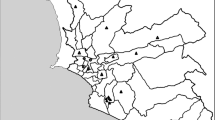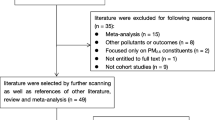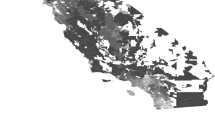Abstract
Mounting studies explored associations between fine particulate matter (PM2.5) and preterm birth (PTB); however, individual and combined impacts of PM2.5 constituents on PTB were less known. PM2.5 and its seven constituents were assessed by V4.CH.02 product of the Dalhousie University Atmospheric Composition Analysis Group, a dataset containing combined geophysical-statistical estimates of PM2.5 across China. Effects of PM2.5 and its constituents on PTB and gestational age were firstly explored. Furthermore, weighted quantile sum (WQS) regression was conducted to reveal the impacts of total PM2.5 mass and identify contributing constituents. An interquartile range (IQR) increase in PM2.5 was associated with increased odds ratio (OR) of PTB. PM2.5 constituents were widely associated with PTB and reduced gestational age, with different time window. The total mass of PM2.5 (per IQR increment) in the first and the second trimester was positively associated with PTB by WQS regression (Trimester 1: OR = 1.38, 95%CI: 1.15, 1.65; Trimester 2: OR = 1.47, 95%CI: 1.21, 1.79). The most contributing factors were black carbon in the first trimester and sulphate ion in the second trimester, respectively. Especially, sea salt was identified as contributing constituent during the first trimester. The study indicated that prenatal exposure to PM2.5 and its constituents was individually and jointly associated with PTB and reduced gestational age. Sea salt was firstly identified as a risk factor of PTB in the seaside city, which needs further exploration.




Similar content being viewed by others
Data availability
The datasets generated during and/or analyzed during the current study are not publicly available due to privacy protection consent, but are available from the corresponding author on reasonable request.
References
Barrett JR (2014) Apples to apples: comparing PM2.5 exposures and birth outcomes in understudied countries. Environ Health Persp 122(4):e110
Basu R, Pearson D, Ebisu K, Malig B (2017) Association between PM2.5 and PM2.5 constituents and preterm delivery in California 2000–2006. Paediatr Perinat Ep 31(5):424–434
Blum JL, Chen LC, Zelikoff JT (2017) Exposure to ambient particulate matter during specific gestational periods produces adverse obstetric consequences in mice. Environ Health Persp 125(7):077020
Bodnar LM, Simhan HN (2008) The prevalence of preterm birth and season of conception. Paediatr Perinat Ep 22(6):538–545
Bove H, Bongaerts E, Slenders E, Bijnens EM, Saenen ND, Gyselaers W et al (2019) Ambient black carbon particles reach the fetal side of human placenta. Nat Commun 10
Cai J, Zhao Y, Kan J, Chen R, Martin R, van Donkelaar A et al (2020) Prenatal exposure to specific PM2.5 chemical constituents and preterm birth in China: a nationwide cohort study. Environ Sci Technol 54(22):14494–14501
Canteiro R, Bahamondes MV, Fernandes AD, Espejo-Arce X, Marchi NM, Bahamondes L (2010) Length of the endometrial cavity as measured by uterine sounding and ultrasonography in women of different parities. Contraception 81(6):515–519
Chang LTC, Scorgie Y, Duc HN, Monk K, Fuchs D, Trieu T (2019) Major source contributions to ambient PM2.5 and exposures within the New South Wales greater metropolitan region. Atmosphere-Basel 10(3)
Chawanpaiboon S, Vogel JP, Moller AB, Lumbiganon P, Petzold M, Hogan D et al (2019) Global, regional, and national estimates of levels of preterm birth in 2014: a systematic review and modelling analysis. Lancet Glob Health 7(1):E37–E46
Chen C, Zhang JW, **a HW, Zhang HX, Betran AP, Zhang L et al (2019) Preterm birth in China between 2015 and 2016. Am J Public Health 109(11):1597–1604
Darrow LA, Klein M, Flanders WD, Waller LA, Correa A, Marcus M et al (2009) Ambient air pollution and preterm birth: a time-series analysis. Epidemiology 20(5):689–698
Feng J, Chan CK, Fang M, Hu M, He L, Tang X (2006) Characteristics of organic matter in PM2.5 in shanghai. Chemosphere 64(8):1393–1400
Fuchs F, Monet B, Ducruet T, Chaillet N, Audibert F (2018) Effect of maternal age on the risk of preterm birth: a large cohort study. PLoS ONE 13(1):e0191002
Guo T, Wang Y, Zhang H, Zhang Y, Zhao J, Wang Q et al (2018) The association between ambient PM2.5 exposure and the risk of preterm birth in China: A retrospective cohort study. Sci Total Environ 633:1453–1459
He Y, Jiang Y, Yang Y, Xu J, Zhang Y, Wang Q et al (2022a) Composition of fine particulate matter and risk of preterm birth: a nationwide birth cohort study in 336 Chinese cities. J Hazard Mater 425:127645
He Y, Jiang YX, Yang Y, Xu JH, Zhang Y, Wang QM et al (2022b) Composition of fine particulate matter and risk of preterm birth: a nationwide birth cohort study in 336 Chinese cities. J Hazard Mater 425
Jaegle L, Quinn PK, Bates TS, Alexander B, Lin JT (2011) Global distribution of sea salt aerosols: new constraints from in situ and remote sensing observations. Atmos Chem Phys 11(7):3137–3157
Kannan S, Misra DP, Dvonch JT, Krishnakumar A (2006) Exposures to airborne particulate matter and adverse perinatal outcomes: a biologically plausible mechanistic framework for exploring potential effect modification by nutrition. Environ Health Persp 114(11):1636–1642
Kock K, Kock F, Klein K, Bancher-Todesca D, Helmer H (2010) Diabetes mellitus and the risk of preterm birth with regard to the risk of spontaneous preterm birth. J Matern-Fetal Neo M 23(9):1004–1008
Kwag Y, Kim MH, Ye S, Oh J, Yim G, Kim YJ et al (2021) The combined effects of fine particulate matter and temperature on preterm birth in Seoul, 2010–2016. Int J Env Res Pub He 18(4):1463
Laurent O, Hu J, Li L, Kleeman MJ, Bartell SM, Cockburn M et al (2016a) Low birth weight and air pollution in California: Which sources and components drive the risk? Environ Int 92–93:471–477
Laurent O, Hu J, Li L, Kleeman MJ, Bartell SM, Cockburn M et al (2016b) A statewide nested case-control study of preterm birth and air pollution by source and composition: California, 2001–2008. Environ Health Persp 124(9):1479–1486
Li HL, Tatarko J, Kucharski M, Dong Z (2015) Pm2.5 and PM10 emissions from agricultural soils by wind erosion. Aeolian Res 19:171–182
Li XY, Huang SQ, Jiao AQ, Yang XH, Yun JF, Wang YX et al (2017) Association between ambient fine particulate matter and preterm birth or term low birth weight: an updated systematic review and meta-analysis. Environ Pollut 227:596–605
Li Q, Wang YY, Guo YM, Zhou H, Wang XB, Wang QM et al (2018) Effect of airborne particulate matter of 2.5 μm or less on preterm birth: a national birth cohort study in China. Environ Int 121:1128–1136
Li B, Zhang X, Peng X, Zhang S, Wang X, Zhu C (2019) Folic acid and risk of preterm birth: a meta-analysis. Front Neurosci 13:1284
Lim SS, Vos T, Flaxman AD, Danaei G, Shibuya K, Adair-Rohani H et al (2012) A comparative risk assessment of burden of disease and injury attributable to 67 risk factors and risk factor clusters in 21 regions, 1990–2010: a systematic analysis for the global burden of disease study 2010. Lancet 380(9859):2224–2260
Lin L, Lu CY, Chen WQ, Li CR, Guo VY (2021) Parity and the risks of adverse birth outcomes: a retrospective study among Chinese. Bmc Pregnancy Childb 21(1)
Liu C, Cai J, Qiao LP, Wang HL, Xu WX, Li HC et al (2017) The acute effects of fine particulate matter constituents on blood inflammation and coagulation. Environ Sci Technol 51(14):8128–8137
Madan J, Chen MH, Goodman E, Davis J, Allan W, Dammann O (2010) Maternal obesity, gestational hypertension, and preterm delivery. J Matern-Fetal Neo M 23(1):82–88
Mayer C, Joseph KS (2013) Fetal growth: a review of terms, concepts and issues relevant to obstetrics. Ultrasound Obstet Gynecol 41(2):136–145
Mendola P, Wallace M, Hwang BS, Liu D, Robledo C, Mannisto T et al (2016) Preterm birth and air pollution: critical windows of exposure for women with asthma. J Allergy Clin Immunol 138(2):432-440 e435
Mendola P, Nobles C, Williams A, Sherman S, Kanner J, Seeni I et al (2019) Air pollution and preterm birth: do air pollution changes over time influence risk in consecutive pregnancies among low-risk women? Int J Env Res Pub He 16(18):3365
Parazzini F, Chatenoud L, Surace M, Tozzi L, Salerio B, Bettoni G et al (2003) Moderate alcohol drinking and risk of preterm birth. Eur J Clin Nutr 57(10):1345–1349
ParizadNasirkandy M, Badfar G, Shohani M, Rahmati S, YektaKooshali MH, Abbasalizadeh S et al (2017) The relation of maternal hypothyroidism and hypothyroxinemia during pregnancy on preterm birth: an updated systematic review and meta-analysis. Int J Reprod Biomed 15(9):543–552
Pope CA, Hansen ML, Long RW, Nielsen KR, Eatough NL, Wilson WE et al (2004) Ambient particulate air pollution, heart rate variability, and blood markers of inflammation in a panel of elderly subjects. Environ Health Persp 112(3):339–345
Preston EV, Webster TF, Claus Henn B, McClean MD, Gennings C, Oken E et al (2020) Prenatal exposure to per- and polyfluoroalkyl substances and maternal and neonatal thyroid function in the project viva cohort: a mixtures approach. Environ Int 139:105728
Purisch SE, Gyamfi-Bannerman C (2017) Epidemiology of preterm birth. Semin Perinatol 41(7):387–391
Saigal S, Doyle LW (2008) An overview of mortality and sequelae of preterm birth from infancy to adulthood. Lancet 371(9608):261–269
Simonsen SME, Lyon JL, Alder SC, Varner MW (2005) Effect of grand multiparity on intrapartum and newborn complications in young women. Obstet Gynecol 106(3):454–460
Sioutas C, Delfino RJ, Singh M (2005) Exposure assessment for atmospheric ultrafine particles (UFPS) and implications in epidemiologic research. Environ Health Persp 113(8):947–955
Stieb DM, Chen L, Beckerman BS, Jerrett M, Crouse DL, Omariba DW et al (2016) Associations of pregnancy outcomes and PM2.5 in a national Canadian study. Environ Health Persp 124(2):243–249
Sun SZ, Weinberger KR, Spangler KR, Eliot MN, Braun JM, Wellenius GA (2019) Ambient temperature and preterm birth: a retrospective study of 32 million us singleton births. Environ Int 126:7–13
Sun Y, Ilango SD, Schwarz L, Wang Q, Chen JC, Lawrence JM et al (2020) Examining the joint effects of heatwaves, air pollution, and green space on the risk of preterm birth in California. Environ Res Lett 15(10):104099
Vadillo-Ortega F, Osornio-Vargas A, Buxton MA, Sanchez BN, Rojas-Bracho L, Viveros-Alcaraz M et al (2014) Air pollution, inflammation and preterm birth: a potential mechanistic link. Med Hypotheses 82(2):219–224
van Donkelaar A, Martin RV, Brauer M, Hsu NC, Kahn RA, Levy RC et al (2016) Global estimates of fine particulate matter using a combined geophysical-statistical method with information from satellites, models, and monitors. Environ Sci Technol 50(7):3762–3772
van Donkelaar A, Martin RV, Li C, Burnett RT (2019) Regional estimates of chemical composition of fine particulate matter using a combined geoscience-statistical method with information from satellites, models, and monitors. Environ Sci Technol 53(5):2595–2611
Weagle CL, Snider G, Li C, van Donkelaar A, Philip S, Bissonnette P et al (2018) Global sources of fine particulate matter: interpretation of PM2.5 chemical composition observed by spartan using a global chemical transport model. Environ Sci Technol 52(20):11670–11681
Wilhelm M, Ghosh JK, Su J, Cockburn M, Jerrett M, Ritz B (2011) Traffic-related air toxics and preterm birth: a population-based case-control study in Los Angeles County, California. Environ Health-Glob 10(89)
Zhang RY, Wang GH, Guo S, Zarnora ML, Ying Q, Lin Y et al (2015) Formation of urban fine particulate matter. Chem Rev 115(10):3803–3855
Zhang ZH, Khlystov A, Norford LK, Tan ZK, Balasubramanian R (2017) Characterization of traffic-related ambient fine particulate matter (PM2.5) in an Asian city: Environmental and health implications. Atmos Environ 161:132–143
Zhang X, Fan C, Ren Z, Feng H, Zuo S, Hao J et al (2020) Maternal PM2.5 exposure triggers preterm birth: A cross-sectional study in Wuhan. China. Global Health Research and Policy 5:17
Funding
This work was supported by National Key Research and Development Program of China (2022YFC2702901) and the Jiangsu Provincial Science and Technology Project (BE2019694).
Author information
Authors and Affiliations
Contributions
All authors contributed to the study conception and design. Material preparation, data collection, and analysis were performed by Chao Dong, Mingzhi Zhang, and Yuhong Zhang. The first draft of the manuscript was written by Chao Dong. Data curation was performed by **aochen Zhang, Yin Zhuang, Yifen Wang, Qian, and Wei Li. Funding acquisition was conducted by Yanyan Yu and Yankai **a. All authors commented on previous versions of the manuscript. All authors read and approved the final manuscript.
Corresponding authors
Ethics declarations
Ethics approval
The study was conducted in accordance with the Declaration of Helsinki and approved by the medical ethics committee of Lianyungang Maternity and Child Health Care Hospital (reference number: LYG-MEP2021014).
Consent to participate
Informed consent was obtained from all individual participants included in the study.
Consent for publication
Not applicable.
Competing interests
The authors declare no competing interests.
Additional information
Publisher's note
Springer Nature remains neutral with regard to jurisdictional claims in published maps and institutional affiliations.
Supplementary Information
Below is the link to the electronic supplementary material.
Rights and permissions
Springer Nature or its licensor (e.g. a society or other partner) holds exclusive rights to this article under a publishing agreement with the author(s) or other rightsholder(s); author self-archiving of the accepted manuscript version of this article is solely governed by the terms of such publishing agreement and applicable law.
About this article
Cite this article
Dong, C., Zhang, M., Zhang, Y. et al. Independent and combined effects of PM2.5 and its constituents on preterm birth: a retrospective study in a seaside city. Air Qual Atmos Health 16, 1661–1672 (2023). https://doi.org/10.1007/s11869-023-01363-8
Received:
Accepted:
Published:
Issue Date:
DOI: https://doi.org/10.1007/s11869-023-01363-8




